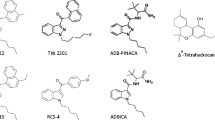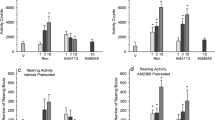Abstract
Rationale
In previous drug discrimination studies we observed surmountable antagonism by Δ9-tetrahydrocannabinol (THC) in the presence of constant doses of SR-141716 [N-(piperidin-1-yl)-5-(4-chloro-phenyl)-1-(2,4-dichlorophenyl)-4-methyl-1H-pyrazole-3-carboxamide] (0.3 and 1 mg/kg), but there was only marginal evidence for surmountable antagonism with combinations of SR-141716 and (R)-methanandamide, a chiral analog of the endocannabioid anandamide.
Objective
Here we examine antagonism where the cannabinoid CB1 receptor agonist [Δ9-THC and (R)-methanandamide] dose is held constant (i.e., the training dose) and the antagonist {i.e., SR-141716 and AM-251 [N-(piperidin-1-yl)-5-(4-iodophenyl)-1-(2,4-dichlorophenyl)-4-methyl-1H-pyrazole-3-carboxamide; 2 ml/kg]} dose varied. We also tested the cannabinoid CB2 receptor antagonist SR-144528 {N-[(1S)-endo-1,3,3-trimethylbicyclo(2.2.1)heptan-2-yl]5-(4-chloro-3-methyl-phenyl)-1-(4-methylbenzyl)pyrazole-3-carboxamide}.
Methods
Different groups of rats were trained to discriminate between vehicle and three different doses of Δ9-THC (1.8, 3, and 5.6 mg/kg, presumably reflecting different efficacy demands) as well as 10 mg/kg (R)-methanandamide. Dose-generalization tests involved different doses of the cannabinoid CB1 receptor agonists. Antagonist tests varied the dose of the antagonist (range: 0.1 and 3 mg/kg for SR-141716 and AM-251, and 1 to 10 mg/kg for SR-144528).
Results
SR-141716 and AM-251 doses dependently blocked the agonist-induced discriminative stimulus effects. SR-141716 tended to be slightly more potent than AM-251. The effective dose 50 (ED50) of SR-141716 was higher in the 5.6 mg/kg Δ9-THC-trained group relative to the two other Δ9-THC-trained groups. The cannabinoid CB2 receptor antagonist SR-144528 combined with the training dose of 1.8 mg/kg Δ9-THC, as well as when combined with the training dose of 10 mg/kg (R)-methanandamide, did not markedly change drug-appropriate (agonist) responses.
Conclusion
Data support that the discriminative stimulus effects of (R)-methanandamide and its overlap with the Δ9-THC cue are, indeed, CB1 receptor mediated events as revealed in antagonism tests with the selective central CB1 receptor antagonists SR-141716 and AM-251. The activation of cannabinoid CB2 receptors appears to be insignificant for these discriminations.





Similar content being viewed by others
References
Abadji V, Lin S, Taha G, Griffin G, Stevenson LA, Pertwee RG, Makriyannis A (1994) (R)-Methanandamide: a chiral novel anandamide possessing higher potency and metabolic stability. J Med Chem 37:1889–1893
Adams IB, Compton DR, Martin BR (1998) Assessment of anandamide interaction with the cannabinoid brain receptor: SR 141716A antagonism studies in mice and autoradiographic analysis of receptor binding in rat brain. J Pharmacol Exp Ther 284:1209–1217
Alici T, Appel JB (2004) Increasing the selectivity of the discriminative stimulus effects of Δ9-tetrahydrocannabinol: complete substitution with methanandamide. Pharmacol Biochem Behav 79:431–437
Burkey RT, Nation JR (1997) (R)-Methanandamide, but not anandamide, substitutes for Δ9-THC in a drug-discrimination procedure. Exp Clin Psychopharmacol 5:195–202
Chambers AP, Sharkey KA, Koopmans HS (2004) Cannabinoid (CB)1 receptor antagonist, AM 251, causes a sustained reduction of daily food intake in the rat. Physiol Behav 82:863–869
De Lago E, de Miguel R, Lastres-Becker I, Ramos JA, Fernandez-Ruiz J (2004) Involvement of vanilloid-like receptors in the effects of anandamide on motor behaviour and nigro-striatal dopaminergic activity: in vivo and in vitro evidence. Brain Res 1007:152–159
Devane WA, Hanus L, Breuer A, Pertwee RG, Stevenson LA, Griffin G, Gibson D, Mandelbaum A, Etinger A, Mechoulam R (1992) Isolation and structure of a brain constituent that binds to the cannabinoid receptor. Science 258:1946–1949
De Vry J, Jentzsch KR (2003) Intrinsic activity estimation of cannabinoid CB1 receptor ligands in a drug discrimination paradigm. Behav Pharmacol 14:471–476
De Vry J, Jentzsch KR (2004) Discriminative stimulus effects of the structurally novel cannabinoid CB1/CB2 receptor partial agonist BAY 59-3074 in the rat. Eur J Pharmacol 505:127–133
De Vry J, Jentzsch KR, Kuhl E, Eckel G (2004) Behavioral effects of cannabinoids show differential sensitivity to cannabinoid receptor blockade and tolerance development. Behav Pharmacol 15:1–12
Extance K, Goudie AJ (1981) Inter-animal olfactory cues in operant drug discrimination procedures in rats. Psychopharmacology 73:363–371
Hàjos N, Freund TF (2002) Pharmacological separation of cannabinoid sensitive receptors on hippocampal excitatory and inhibitory fibers. Neuropharmacology 43:503–510
Holtzman SG (1985) Drug discrimination studies. Drug Alcohol Depend 14:263–282
Janoyan JJ, Crim JL, Darmani NA (2002) Reversal of SR 141716A-induced head-twitch and ear-scratch responses in mice by Δ9-THC and other cannabinoids. Pharmacol Biochem Behav 71:155–162
Järbe TUC, Rollenhagen C (1978) Morphine as a discriminative cue in gerbils: drug generalization and antagonism. Psychopharmacology 58:271–275
Järbe TUC (1989) Discrimination learning with drug stimuli: methods and applications. In: Boulten AA, Baker GB, Greenshaw AJ (eds) Neuromethods. Psychopharmacology, vol 13. Humana, Clifton, pp 513–563
Järbe TUC, Lamb RJ, Makriyannis A, Lin S, Goutopoulos A (1998) Δ9-THC training dose as a determinant for (R)-methanandamide generalization in rats. Psychopharmacology 140:519–522
Järbe TUC, Lamb RJ, Lin S, Makriyannis A (2000) Δ9-THC training dose as a determinant for (R)-methanandamide generalization in rats: a systematic replication. Behav Pharmacol 11:81–86
Järbe TUC, Lamb RJ, Lin S, Makriyannis A (2001) (R)-Methanandamide and Δ9-THC as discriminative stimuli in rats: tests with the cannabinoid antagonist SR-141716 and the endogenous ligand anandamide. Psychopharmacology 156:369–380
Järbe TUC, Andrzejewski ME, DiPatrizio NV (2002) Interactions between the CB1 receptor agonist Δ9-THC and the CB1 receptor antagonist SR-141716 in rats: open-field revisited. Pharmacol Biochem Behav 73:911–919
Järbe TUC, DiPatrizio NV, Li C, Makriyannis A (2003a) The cannabinoid receptor antagonist SR-141716 does not readily antagonize open-field effects induced by the cannabinoid receptor agonist (R)-methanandamide in rats. Pharmacol Biochem Behav 75:809–821
Järbe TUC, Lamb RJ, Liu Q, Makriyannis A (2003b) (R)-Methanandamide and Δ9-THC induced operant rate decreases in rats are not readily antagonized by SR-141716A. Eur J Pharmacol 466:121–127
Järbe TUC, Harris MY, Li C, Liu Q, Makriyannis A (2004a) Discriminative stimulus effects in rats of SR-141716 (rimonabant), a cannabinoid receptor CB1 antagonist. Psychopharmacology 177:35–45
Järbe TUC, DiPatrizio NV, Lu D, Makriyannis A. (2004b) (−)-Adamantyl-Δ8-tetrahydrocannabinol (AM-411), a selective cannabinoid CB1 receptor agonist: effects on open-field behaviors and antagonism by SR-141716 in rats. Behav Pharmacol 15:517–521
Justinova Z, Solinas M, Tanda G, Redhi GH, Goldberg SR (2005) The endogenous cannabinoid anandamide and its synthetic analog R(+)-methanandamide are intravenously self-administered by squirrel monkeys. J Neurosci 25:5645–5650
Lan R, Fernando S, Fan P, McCallion D, Liu Q, Pertwee R, Makriyannis A (1999) Structure–activity relationships of pyrazole derivatives as cannabinoid receptor antagonists. J Med Chem 42:769–776
Mauler F, Mittendorf J, Horvath E, De Vry J (2002) Characterization of the diarylether sulfonylester (−)-(R)-3-(2-hydroxymethylindanyl-4-oxy)phenyl-4, 4, 4-trifluoro-1-sulfonate (BAY 38-7271) as a potent cannabinoid receptor agonist with neuroprotective properties. J Pharmacol Exp Ther 302:1–10
National Institutes of Health (1996) Principles of Animal Laboratory Care. National Academy Press, Washington, D.C.
Pério A, Rinaldi-Carmona M, Maruani J, Barth F, Le Fur G, Soubrié P (1996) Central mediation of the cannabinoid cue: activity of a selective CB1 antagonist, SR 141716A. Behav Pharmacol 7:65–71
Pertwee RG (2005) Inverse agonism and neutral antagonism at cannabinoid CB1 receptors. Life Sci 76:1307–1324
Rinaldi-Carmona M, Barth F, Heaulme M, Shire D, Calandra B, Congy C, Martinez S, Maruani J, Neliat G, Caput D, Ferrara P, Soubrié P, Breliere JC, LeFur G (1994) SR141716A, a potent and selective antagonist of the brain cannabinoid receptor. FEBS Lett 350:240–244
Rinaldi-Carmona M, Barth F, Millan J, Derocq JM, Casellas P, Congy C, Oustric D, Sarran M, Bouaboula M, Calandra B, Portier M, Shire D, Breliére JC, LeFur G (1998) SR 14528, the first potent and selective antagonist of the CB2 cannabinoid receptor. J Pharmacol Exp Ther 284:644–650
Stolerman IP (1993) Drug discrimination. In: van Haaren F (ed) Methods in behavioral pharmacology. Elsevier, Amsterdam, pp 217–243
Tanda G, Munzar P, Goldberg SR (2000) Self-administration behavior is maintained by the psychoactive ingredient of marijuana in squirrel monkeys. Nature Neurosci 3:1073–1074
Thakur GA, Nikas SP, Li C, Makriyannis A (2005) Structural requirements for cannabinoid receptor probes. In: Pertwee R (ed.) Handbook of experimental pharmacology, vol 168. Springer, Berlin Heidelberg New York, pp 209–246
Vlachou S, Nomikos GG, Panagis G (2005) CB1 cannabinoid receptor agonists increase intracranial self-stimulation thresholds in the rat. Psychopharmacology 179:498–508
Wiley JL, Balster RL, Martin BR (1995) Discriminative stimulus effects of anandamide in rats. Eur J Pharmacol 276:49–54
Wiley JL, Golden KM, Ryan WJ, Balster RL, Razdan RK, Martin BR (1997) Evaluation of cannabimimetic discriminative stimulus effects of anandamide and methylated fluoroanandamide in rhesus monkeys. Pharmacol Biochem Behav 58:1139–1143
Wiley JL, LaVecchia KL, Karp NE, Kulasegram S, Mahadevan A, Razdan RK, Martin BR (2004) A comparison of the discriminative stimulus effects of delta(9)-tetrahydrocannabinol and O-1812, a potent and metabolically stable anandamide analog, in rats. Exp Clin Psychopharmacol 12:173–179
Acknowledgements
United States Public Health Service Grants DA 09064, 00253, and 13429 (Philadelphia) and DA 03801, 9158, 7215, and 00152 (Boston) from the National Institute on Drug Abuse (NIDA) supported this work. We thank Michelle Harris for technical assistance. We also thank NIDA for supplies of (−)-Δ9-THC and SR-141716 (as the base).
Author information
Authors and Affiliations
Corresponding author
Rights and permissions
About this article
Cite this article
Järbe, T.U.C., Liu, Q. & Makriyannis, A. Antagonism of discriminative stimulus effects of Δ9-THC and (R)-methanandamide in rats. Psychopharmacology 184, 36–45 (2006). https://doi.org/10.1007/s00213-005-0225-y
Received:
Accepted:
Published:
Issue Date:
DOI: https://doi.org/10.1007/s00213-005-0225-y




